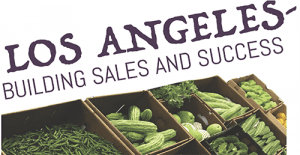Despite advances, technology or otherwise, import challenges are many.

Importers have a plethora of regulations, new and old, to meet. Lynnette Keffer, president of customs broker J & K Fresh LLC, located in El Segundo, says these range from the Food Safety Rule, antiterrorism procedures, holding for x-ray inspections, and all manner of inspections from U.S. customs officials, the USDA, Animal and Plant Health Inspection Service (APHIS), and Food and Drug Administration.
“I used to liken customs to a three-layer cake,” Keffer says. “Now it’s layers within layers—in each division, there are more layers of inspections and requirements and it seems to be increasing. One of the toughest new rules is from the FDA, the Foreign Supplier Verification Program, to ensure that foreign produce meets the same standards as domestic.”
Cole Firman, salesman at specialty wholesaler Coosemans LA Shipping Inc., Vernon, says some imported commodities have more regulations than others. For example, if there are “a lot of stems and leaves, we have to complete more paperwork because of the increased potential for infestation. It’s a challenge to promote these items because of the extra documentation required.”
“Then there’s some really unusual stuff out there, like gac fruit from Southeast Asia,” Firman continues. “It hasn’t been available much commercially, but we thought we’d give it a try. Pitaya or dragon fruit from Vietnam is sometimes difficult to import due to its propensity for harboring pests.”
To give some idea of what it takes to import dragon fruit, APHIS specifies, “It must be packed in insect-proof boxes and safeguarded after treatment to prevent the risk of subsequent pest infestation. Then the fruit must also be accompanied by a phytosanitary certificate issued by the national plant protection organization of Vietnam with additional declarations certifying that the fruit’s treatment and inspection were completed in compliance with USDA regulations.”
Dragon fruit does make its way into the United States, but there are many hoops to jump through just to add this particular “wow” factor to the produce section. Still, this is California, where innovation and the “next big thing” are highly prized.
In addition to navigating bureaucracy, there are always frustrations as a result of labor and transportation. James Alvarez, president of Olympic Fruit & Vegetable Distributors/Coast Tropical on the market says, with a hint of exasperation, “It’s almost easier to get shipments from Miami to L.A. than from L.A. and Long Beach. Smaller shippers have to wait weeks for their produce to come through the ports, and the POLA/POLB can be the worst.”
“Things generally go smoothly for us because our growers know how to complete the paperwork perfectly,” he says. “When things aren’t done just right, there are red flags that lead to added inspections that add delays, which add to costs.”
“In the United States, the shipper is responsible for the correct paperwork, inspections, and documents even though they don’t have control of the load,” he continues. “Europe is easier—the ships control the loads. Additionally, European ports are automated, so they’re more efficient.
“The European Union operates with 800 workers versus 10,000 union workers at the San Pedro port complex. And with the new law that limits truck drivers to 10 hours at a time, you have to put on two drivers for a trip to Las Vegas or put the one driver up overnight.”
This is an excerpt from the most recent Produce Blueprints quarterly journal. Click here to read the full article.


